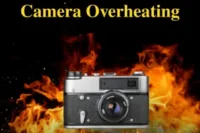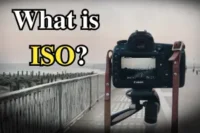Best Types of Camera Filters for All Photography Styles
Published: 12 Jul 2025
When it comes to photography, camera filters play an essential role in shaping the final image. Whether you’re shooting landscapes, portraits, or anything in between, the right camera filter can improve your photos and give you more creative control over your shots.
In this comprehensive guide, we’ll explore the different types of camera filters, their uses, and how they can take your photography to the next level. So, let’s get started.
What Are Camera Filters and Why Do You Need Them?
A camera filter is a transparent optical element placed in front of a camera lens to modify the incoming light before it reaches the camera’s sensor or film. Filters help control exposure, color, contrast, and special effects, allowing you to capture the image you want without relying on post-editing.
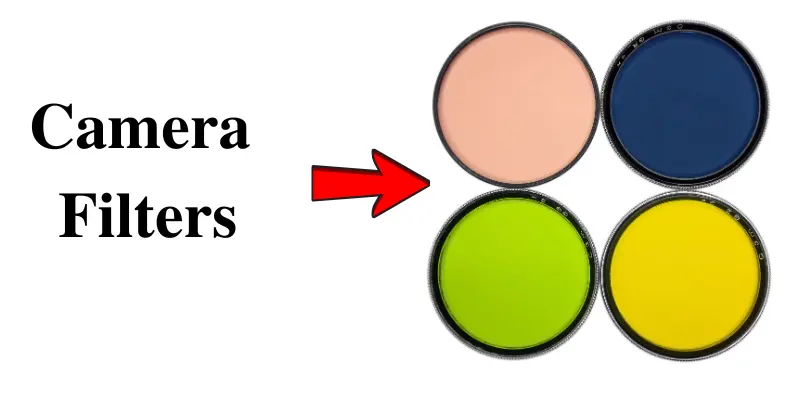
Now that you know what camera filters are, let’s explore why they’re essential for your photography:
- Control Exposure: ND filters reduce the amount of light, allowing longer exposures even in bright conditions, such as capturing flowing water or smooth cloud movement.
- Enhance Colors: Polarizing filters (CPL) reduce glare and deepen the colors of the sky, making landscapes stand out and water reflections appear more transparent.
- Protect Your Lens: Clear or UV filters act as a protective barrier, shielding your lens from scratches, dust, and moisture.
- Create Artistic Effects: Filters like star and bokeh filters allow you to add creative touches to your photos, such as turning bright light sources into starbursts or creating fun shapes in out-of-focus areas.
Types of Camera Filters
Let’s explore the different kinds of camera filters, their purpose, when to use them, and trusted brands that offer them.
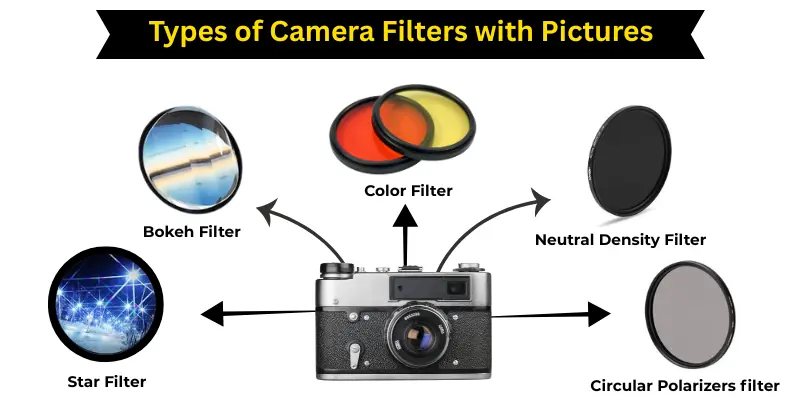
1. Protective Filters
These filters are designed to protect your lens from dust, scratches, moisture, and UV light. While they don’t usually affect your image quality, they’re essential for keeping your equipment safe.
Clear Filters
Clear filters are transparent optical elements that don’t alter the colors or contrast of your image. They serve as a protective shield for your camera lens, keeping it safe from dirt, dust, moisture, or scratches.
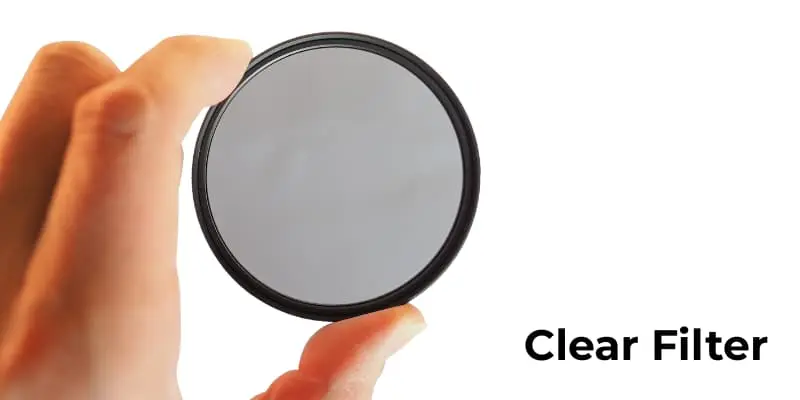
Use Case:
- Protects the lens from dust, dirt, moisture, and scratches, ensuring it stays in top condition.
- It is ideal for outdoor shoots in challenging weather conditions, like rain or snow.
- It provides an additional layer of protection in crowded environments or when shooting in dust-heavy locations.
Popular Brands: Hoya, B+W
UV Filters
UV filters block ultraviolet (UV) light, which can cause haziness or a bluish tint in outdoor photos, especially in high-altitude locations. Though less critical for modern digital sensors, they still provide lens protection and reduce UV-related haze.
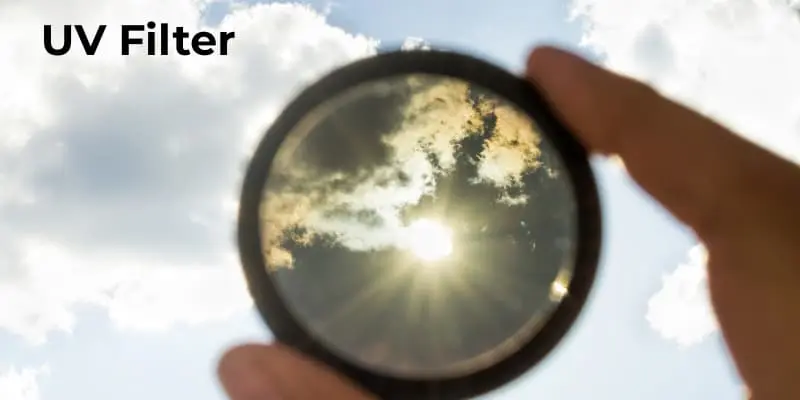
Use Case:
- Reduces haze and the bluish tint caused by UV light, particularly in high-altitude or snowy environments.
- Protects your lens from harmful UV light and environmental damage.
- It enhances clarity and contrast in bright sunlight, making outdoor photography more vibrant and clear.
Popular Brands: Hoya, Tiffen
2. Creative & Color Filters
Photography isn’t just about what you capture — it’s about how you express it. Creative and color filters allow you to add mood, drama, and artistic flair to your photos, whether you’re shooting portraits, landscapes, or black-and-white scenes.
Color Filters
Color filters are tinted glass or plastic filters that change how colors are recorded by the camera. They’re especially popular in black-and-white photography, where different color filters can dramatically affect how light and dark areas appear.
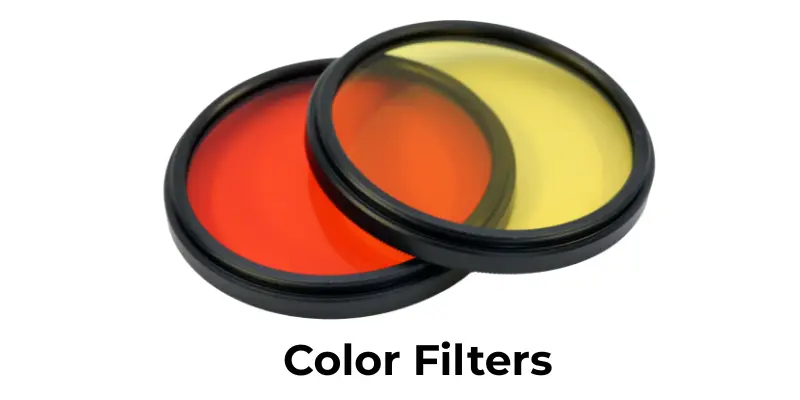
Use Cases:
- Boost contrast in black-and-white shots by filtering specific color tones.
- A red filter, for example, makes blue skies look darker and clouds more dramatic.
- Ideal for creative portraits, moody landscapes, or fine art photography.
Popular Brands: B+W, Tiffen
Soft Filters
Soft filters are designed to gently blur and spread the light across the image, creating a gentle, glowing effect. They don’t make the photo out of focus; instead, they soften sharp edges, which is great for skin tones.
Use Cases:
- Often used by portrait and wedding photographers to achieve a smooth, glowing appearance on the skin.
- Adds a warm, dream-like feel to romantic or vintage–themed shoots.
- Useful when you want your subject to look flattering and the background to feel light and airy.
Popular Brands: Hoya, B+W
Star Filters
Star filters are special effects filters that turn any bright point of light into a starburst pattern, with 4, 6, or even 8 rays. The effect is created by etched lines on the filter’s surface.
Use Cases:
- Perfect for nighttime photography, such as street scenes, cityscapes, or festive lights.
- Adds a magical or cinematic vibe to images, making them great for holiday events or creative shoots.
- It works best when there’s a direct light source like street lamps, headlights, or candles.
Popular Brands: Hoya, Tiffen
Bokeh Filters
Bokeh filters are all about fun and creativity. They shape the blurred background lights (called bokeh) into attractive designs like hearts, stars, or snowflakes, adding a playful twist to your photos. Instead of the usual round blur, you get custom patterns that add a unique, artistic feel to portraits or themed shoots.
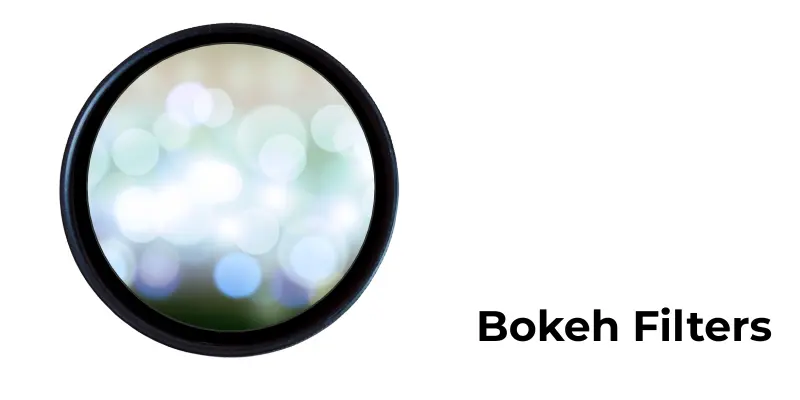
Use Cases:
- Add a playful or romantic touch to portraits, especially during holidays or themed photoshoots.
- Create eye-catching product photography with fun background effects.
- Ideal for Valentine’s Day, Christmas, or birthday shoots to add a personal touch to your photos.
Popular Brands: Hoya, B+W
3. Light Control Filters
Light control filters help you manage brightness in your shots. They give you more creative control over exposure, aperture, and contrast, especially in bright or uneven lighting.
Neutral Density (ND) Filters
ND filters reduce the amount of light entering your camera’s lens without affecting color. This allows you to use slower shutter speeds or wider apertures, even in bright lighting conditions.
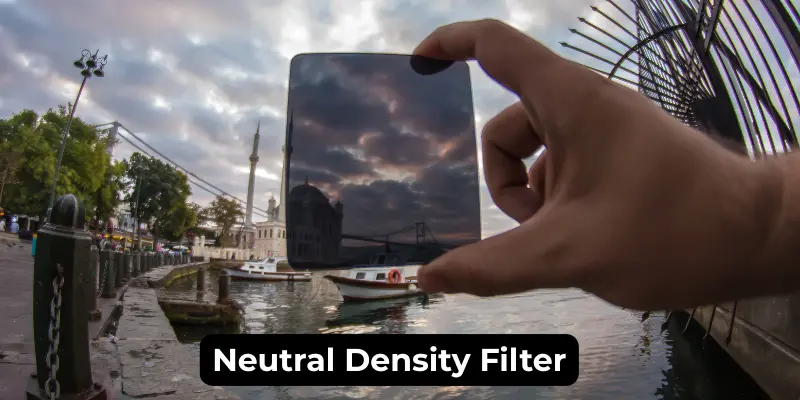
Use Cases:
- Create smooth, flowing effects in waterfalls, rivers, and oceans.
- Blur moving clouds to give landscapes a dreamy or surreal look.
- Ideal for daylight long exposures without overexposing the image.
Popular Brands: Hoya, B+W, Tiffen
Graduated ND Filters
Graduated Neutral Density (GND) filters are dark on one half and clear on the other. They’re used to balance the exposure between a bright sky and a darker foreground, which is especially useful in landscape photography.
Use Cases:
- Helps to capture sunsets and sunrises without blowing out the sky.
- Balances contrast when the upper part of the scene (sky) is much brighter than the bottom.
- Useful when you want to maintain details in both the clouds and the land.
Popular Brands: Lee Filters, Tiffen
Reverse ND Filters
Reverse ND filters are darkest at the center and gradually fade toward the top and bottom. They’re specially designed for scenes where the horizon is the brightest part, like sunrise or sunset.
Use Cases:
- Controls the bright light along the horizon line during golden hours.
- Prevents overexposure in the middle of the frame while keeping the sky and foreground balanced.
- Great for dramatic sunrise or sunset shots where the sun sits near the horizon.
Popular Brands: Hoya, Lee Filters
Variable ND Filters
Variable ND filters allow you to control the light reduction by rotating the filter. Think of it as a dimmer switch for your lens — ideal when lighting changes quickly.
Use Cases:
- Perfect for shooting video in outdoor settings with changing light conditions.
- Allows for on-the-go exposure control without the need to swap filters.
- Helps maintain consistent exposure when capturing scenes with movement or light changes.
Popular Brands: B+W, Hoya, Tiffen
4. Polarizing Filters
Polarizing filters help to control light reflection and improve color quality in your photos. They’re perfect for shooting scenes with glass, water, or shiny surfaces and are especially loved by landscape photographers for enhancing the colors of the sky and leaves.
Circular Polarizers (CPL)
Circular polarizing filters reduce glare and unwanted reflections from non-metallic surfaces like water or glass. They also deepen color tones, making the sky bluer and the greens more vibrant.
Use Cases:
- Cut reflections on lakes, windows, and wet surfaces.
- Make skies more vibrant, and clouds stand out in landscape shots.
- Boost color saturation without editing.
Popular Brands: B+W, Hoya, Tiffen
Linear Polarizers
Linear polarizers perform the same basic function as circular ones but are designed for manual focus or older film cameras. They don’t work well with modern autofocus systems because they can interfere with light metering and focusing mechanisms.
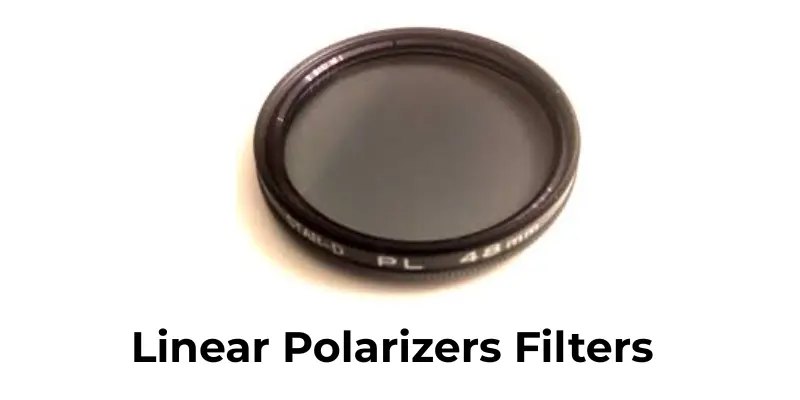
Use Cases:
- Great for use with vintage film cameras or manual lenses
- Cuts reflections and improves contrast in outdoor scenes.
- Ideal for photographers using fully manual setups.
Popular Brands: B+W, Hoya
5. Specialty Filters
Specialty filters are designed for unique, creative effects or niche photography styles. From capturing invisible light to achieving cinematic flares, these filters allow you to experiment and push the boundaries of what your camera can do.
Infrared (IR) Filters
Infrared filters block all visible light and allow only infrared light to reach your camera’s sensor. This type of light isn’t visible to the human eye, so it gives your photos a surreal, otherworldly look.
Use Cases:
- Create otherworldly landscape shots where leaves appear white, and skies turn dark.
- Create a mysterious, high-contrast effect for nature and outdoor photos.
- Popular with creative photographers who want to try artistic or unique infrared photography.
Popular Brands: Hoya, B+W
Astro Filters
Astro filters reduce light pollution from sources like streetlights and buildings, helping you capture clearer, more detailed photos of stars and galaxies even in city areas.
Use Cases:
- Enhance stars, planets, and deep-sky objects when shooting in light-polluted areas.
- Make night sky photos sharper and more vibrant.
- Great for Milky Way, Star Trail, or deep-space photography.
Popular Brands: Hoya, Tiffen
Anamorphic Filters
Anamorphic filters recreate the cinematic look of pro movie lenses by adding horizontal flares and a wide-screen feel. They don’t reshape your image but give your videos a film-like, polished style, which is great for creators and filmmakers.
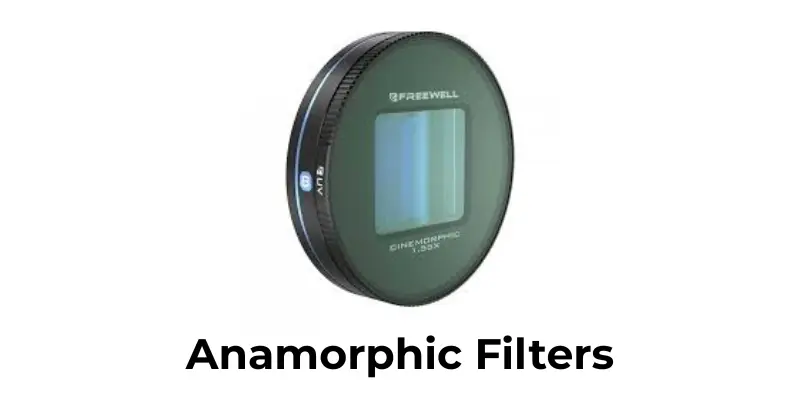
Use Cases:
- Add a film-like, widescreen effect to videos with lens flares.
- Perfect for filmmakers and creators who want a cinematic style.
- Adds a professional touch to storytelling or creative video content.
Popular Brands: B+W, Hoya
How to Choose the Right Lens Filter
Now that you’ve explored the different types of lens filters and their uses, it’s time to decide which one best suits your photography needs. Whether you’re just starting or looking to upgrade your kit, this section will help you make an informed choice.
1. Define Your Photography Objective
Before selecting a filter, identify the specific result you’re aiming for:
| Goal | Best Filter Type |
|---|---|
| Lens protection from dust, scratches, or moisture | Clear or UV Filter |
| Long exposures in bright light | Neutral Density (ND) Filter |
| Balanced exposure between sky and foreground | Graduated ND / Reverse ND |
| Cut reflections from water, glass, or shiny surfaces | Circular Polarizer (CPL) |
| Boost contrast in black-and-white photos | Color Filters |
| Add cinematic lens flares and a widescreen look | Soft Filter |
| Add cinematic lens flares and widescreen look | Anamorphic Filter |
| Reduce city light pollution in night sky shots | Astro Filter |
| Capture surreal, infrared-style landscapes | Infrared (IR) Filter |
| Highlight the light points as starbursts | Bokeh Filter |
| Highlight light points as starbursts | Star Filter |
2. Evaluate the Lighting Conditions
Different filters perform in different lighting scenarios:
- For Bright daylight → Use ND or CPL filters to control light and reflections.
- For High-contrast scenes (e.g., sunrise/sunset) → Use Graduated or Reverse ND filters.
- For Urban night skies → Use Astro filters to reduce light pollution.
- For Creative studio or themed shoots → Try Soft, Color, or Bokeh filters for artistic effects.
3. Check Filter Compatibility with Your Lens
Lens filters come in various sizes, usually measured in millimeters (e.g., 52mm, 67mm, 77mm). To find the correct size:
- Look for the filter thread size printed on your lens or lens cap (marked with a “Ø” symbol).
- Choose filters that match your lens diameter, or use step-up rings for converting smaller filters to larger lenses.
4. Invest in Trusted Brands
High-quality filters ensure better optical performance, minimal distortion, and improved durability. Consider the following reliable brands:
- Hoya – Well-balanced performance and value
- B+W – Premium build and optical quality
- Tiffen – Trusted in both photography and filmmaking
- Lee Filters – Popular among landscape professionals
5. Start Simple, Then Explore
For beginners:
- Start with UV or CPL filters for basic protection and reflection control.
- Experiment with an ND filter to learn long exposure techniques.
As your skills grow, experiment with specialty filters such as Infrared, Astro, and Anamorphic to enhance your creativity.
Conclusion
Understanding the various types of camera filters is important for every photographer, whether you’re just beginning or looking to enhance your creative toolkit. Each filter serves a unique purpose, from controlling light to adding artistic effects, and knowing when to use them can truly elevate your photography.
There’s no one perfect filter for every situation. The best option depends on your subject, lighting, and creative goals.
So take your time, experiment with different filters, and discover how each one can transform your images.
Frequently Asked Questions (FAQs)
Here are answers to some of the most common questions about different types of camera filters :
Some of the top-rated filter brands are Hoya, B+W, Tiffen, and Lee Filters. These brands offer great optical quality, durability, and trusted performance. Hoya and Tiffen are especially good for beginners looking for value and quality.
Camera lens filters help control light, reduce reflections, boost colors, and add creative effects to your photos. They can also protect your lens from scratches and dust. Each type of filter has a specific use, depending on your needs.
A light filter, like an ND or polarizing filter, controls how much light enters your camera lens. This helps you shoot in bright conditions or create long exposure effects. It’s useful for both creative and technical photography.
It depends on your photography goals. Use a UV filter for protection, ND filters for long exposures, CPL filters for cutting glare, and soft filters for portraits. Think about your subject, lighting, and what effect you want to create.
Just screw the filter onto your lens and adjust your camera settings as needed. For ND filters, slow down the shutter speed to blur motion; for CPL filters, rotate it until the reflections are reduced. Practice with different filters to see what works best in each scene.

- Be Respectful
- Stay Relevant
- Stay Positive
- True Feedback
- Encourage Discussion
- Avoid Spamming
- No Fake News
- Don't Copy-Paste
- No Personal Attacks

- Be Respectful
- Stay Relevant
- Stay Positive
- True Feedback
- Encourage Discussion
- Avoid Spamming
- No Fake News
- Don't Copy-Paste
- No Personal Attacks



